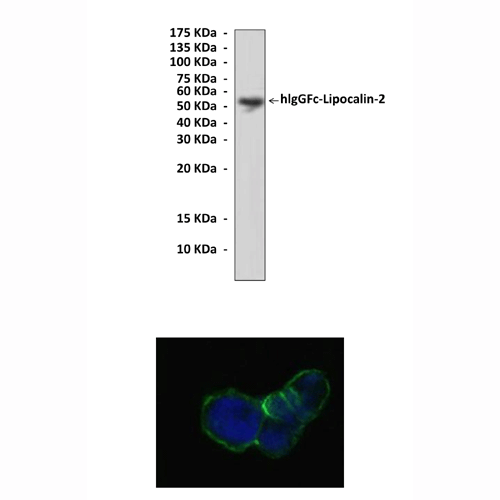Anti-LCN-1: Mouse Lipocalin-1 Antibody |
 |
BACKGROUND Lipocalin-1 (LCN-1), a member of the lipocalin superfamily that binds a broad array of different chemical classes of lipophilic ligands. Ligands include fatty acids, phospholipids, cholesterol, fatty alcohols and glycolipids. In human tears, LCN1 functions to scavenge fatty acids and phospholipids rapidly from the corneal surface and probably to stabilize the tear film surface interface. LCN1 is also believed to act as a physiological scavenger of potentially harmful lipophilic molecules.1 It was thought to be produced exclusively by a number of exocrine glands and tissues, including lachrymal and lingual glands, prostate, secretory glands of the tracheobronchial tract, and sweat glands. However, it was demonstrated that LCN-1 expression was in human pituitary gland. Moreover, LCN-1 is specifically produced by corticotrophs, clearly indicating that its distribution is not restricted to exocrine tissues.2 LCN1 also exhibits cysteine proteinase inhibitor and the binding of fungal siderophores confers antimicrobial activity to LCN1.3 In addition, LCN1, as well as other proteins of the lipocalin family, exhibits magnesium dependent endonuclease activity.4 It may also play a role in taste reception.
REFERENCES
1. Akerstrome, B. et al: Biochem. Biophy. Acata 1482:1-8, 2000
2. Wojnar, P. et al: J. Histochem. Cytochem. 50:433-435, 2002
3. Redl, B. et al: Lab. Investigat. 78:1121-9, 1998
4. Wojnar, P. et al: J. Biol. Chem. 276:20206-12, 2001
2. Wojnar, P. et al: J. Histochem. Cytochem. 50:433-435, 2002
3. Redl, B. et al: Lab. Investigat. 78:1121-9, 1998
4. Wojnar, P. et al: J. Biol. Chem. 276:20206-12, 2001
Products are for research use only. They are not intended for human, animal, or diagnostic applications.
Параметры
Cat.No.: | CP10152 |
Antigen: | Purified recombinant human Lipocalin-1 fragments expressed in E. coli. |
Isotype: | Mouse IgG1 |
Species & predicted species cross- reactivity ( ): | Human |
Applications & Suggested starting dilutions:* | WB 1:1000 IP n/d IHC n/d ICC 1:200 FACS n/d |
Predicted Molecular Weight of protein: | 20 kDa |
Specificity/Sensitivity: | Detects Lipocalin-1 proteins without cross-reactivity with other family members. |
Storage: | Store at -20°C, 4°C for frequent use. Avoid repeated freeze-thaw cycles. |
*Optimal working dilutions must be determined by end user.
Документы
Информация представлена исключительно в ознакомительных целях и ни при каких условиях не является публичной офертой








